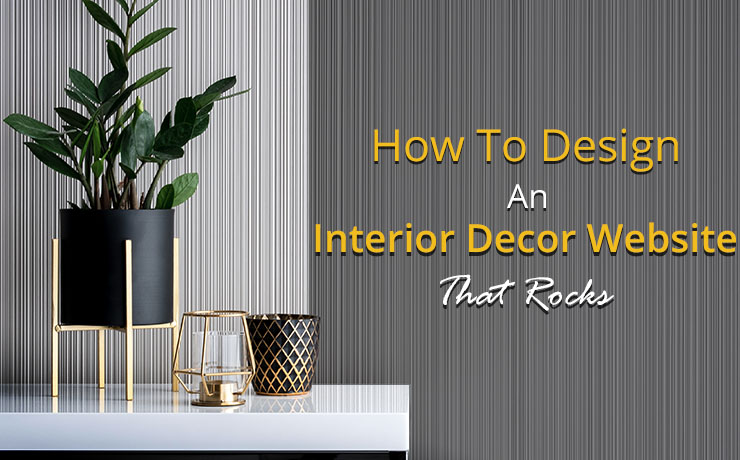How To Design An Interior Decor Website That Rocks

Ashley Moffitt
Senior Project Manager

A website represents your business and reflects who you are as a designer. Therefore, your interior décor website needs to be inviting, inspiring, and just as importantly, user-friendly. If your website is disorganized, difficult to navigate, or looks unprofessional, you may not be trusted to create a beautiful and cohesive interior for a client.
In order to be successful, creative professionals face increasing pressure to have a well-designed, innovative, and exciting website. However, knowing how to design the perfect website may not be a skill you currently possess. So, we’ve assembled some suggestions and best practices to optimize your site and impress your potential clients with an interior décor website that rocks.
Step One – Create an Overall Plan
Throughout your career, you’ve created plans for clients to help them understand what one room or an entire home will eventually look like. You show them floor plans, fabric and tile samples, paint colors, furniture, etc. Now you need to take the same steps for your own website.
Decide what is the most important information your potential clients need to know. Determine who your audience is – are they young professionals, families, or retirees? That will influence your messages and help you create the content for your pages.
Here are several page suggestions that your website should include:
All About You
With interior décor, you meet face to face with people on a daily or weekly basis. Add a bio to your interior décor website to make it feel more personal. Let clients know who they will be working with – mention not only your professional accomplishments, but also a few personal interests, a funny story, or something about your family or pets. Don’t forget to include a photo of yourself, too.
Your Décor and Design Services
Not everyone wants a complete makeover for their entire home. Be sure to list all of the specific services you provide from the first free consultation, help with selecting colors or furniture, space planning, to complete kitchen or bath remodeled designs, etc.
Your Décor Portfolio
The content of this page on your interior décor website is probably the most important. This is where you get to show off all your hard work to potential clients.
The best way to organize these pages is by style i.e., traditional, modern, formal, casual, etc., or by room – living rooms, kitchens, bedrooms, etc. This will assist your clients to find the work you’ve done that matches what they need. Keep the portfolio fairly clean and simple by adding several photos or short video content (include “before-and-after” shots when you can) of each project. Use keywords to help with SEO (search engine optimization) as you describe your work. Be aware that this text will provide the perfect opportunity to highlight your creative and interesting personality as well as showing clients the excellent décor work you do.
Press and Testimonials
Have you ever been featured in a magazine or newspaper? Are you a contributing editor to another website? Share this coverage, if so. It’s the best way to showcase your talent as a decorator.
If you haven’t had this kind of coverage, then the next best thing are testimonials from past clients. They can be your greatest asset. Ask a few people to write a short comment about their experience with you and post them to your website. This can add a lot of credibility to your work.
Step Two – Designing Your Website
Designing your professional interior décor website should be fun. Use your creativity to build your site by thinking of it as one of your interior design projects: focus on the structure and use a few statement pieces to add personality. Here are several other suggestions:
The Background
Allow your potential clients to focus on your décor style, photos, and descriptions without being distracted. Choose a single, solid color, not an image or images, as background wallpaper to reflect your brand aesthetic.
Your Font
The font for your website’s content should be easy to read and sans-serif. Consider “clean” fonts such as Calibri or Ariel. Any decorative fonts should be kept to a minimum because they can be illegible to many viewers and potential clients.
Your Images
Not just your portfolio pages, but any other images you post on your site should be of the highest quality. Try to use photos from work you have done or of your clients, but have your clients sign a release when you use their images.
If you must use other kinds of photos or images, i.e. families, individuals, buildings, landscapes, etc., there are many beautiful and free stock photos to use from a number of other sites. In addition, if you use stock photos of people, be sure to choose a variety of ages and races.
Research Competitors
Take some time and research as to how other designers and decorators created their sites. What photos did they use? How did they describe their projects? How were the pages organized? What services do they offer? This will help you visualize what you like and don’t like about each website to take the best ideas for your own.
The Structure
Make an outstanding impression with a great homepage first. Then, in order to keep your website user-friendly, it’s important to keep the structure of the rest of your site as simple as possible. Navigation should be kept to a minimum and use drop-down menus to direct visitors to additional pages around your site. The menu across the top of the site should include titles such as: Home, About, Portfolio, Design Services, Contact, and Testimonials. Most importantly, have your phone number and contact information on each page. Don’t make it difficult for potential clients to hire you.
Step Three – Get Discovered
When people are searching for a designer or decorator, how do you make certain your site shows up on the first page? It’s vital to work on your search engine optimization (SEO) by using keywords, adding blogs, and keeping your site up to date with new photos and comments.
Although SEO may be a foreign topic to you, there are quick fixes that you can do to help. Here are a few things you should focus on:
Local Searches
Update all of your business listings to be certain your phone number and address look exactly the same on each one. For example, if one listing says “17th St.”, and another has your address as “17th Street” it can make a difference as to where you fall in search pages. Be certain that you are registered with GMB (Google My Business) as well, to show up on search results and maps in your area and beyond.
Use Your Alt Tags
This is highly significant for your portfolio as a designer or decorator. Alternative text (or alt tags) are the descriptions used for the images and photos on your site. The actual raw file should be saved with a targeted keyword whenever you add images to your website. Once it’s been uploaded, you should add the targeted keyword to the alt text of the image.
Share Your Content to Other Sites
Another way to boost your SEO is to add your content onto additional sites. Share your activities, photos, and blog updates, on Facebook, Twitter, Instagram, Pinterest, and even other décor blogs as often as possible.
Elevate Your Business with SmartSites
Not sure if you can design your own website? You’re in luck, because SmartSites is here to help.
Get your business noticed with a creative and beautiful website designed by SmartSites. With a new, user-friendly site, you can grow your décor services and win more customers.
Our SmartSites award-winning design team will tailor your interior décor website to create, grow, or reflect your brand. We will work with you to plan your site right from the start. We add detailed search keywords and tailor your site to drive results. Your site will look great on all devices and load extremely fast. Contact SmartSites today!
 Free
Consultation
Free
Consultation Free
Google Ads Audit
Free
Google Ads Audit







